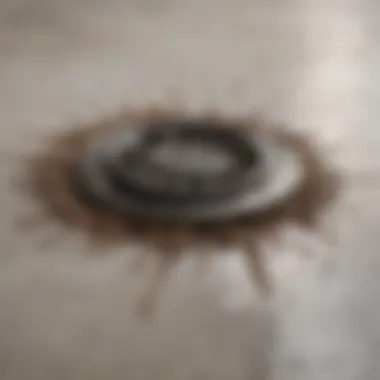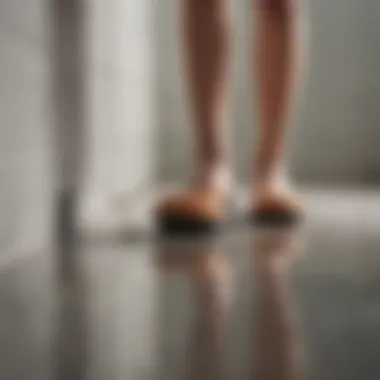Comprehensive Guide to Unclogging Shower Drains


Intro
A clogged shower drain can be both a nuisance and a sign of unresolved issues in your plumbing system. Understanding the causes and consequences of this common challenge is crucial for effective resolution. This guide aims to provide you with valuable insights, discussing not only how to deal with a clogged shower drain but also what can be done to prevent future occurrences. It is essential for homeowners and individuals to grasp the nuances of their plumbing systems.
Causes of Clogged Shower Drains
Several factors contribute to shower drain blockages. Hair accumulation is one of the most frequent causes. Hair strands can combine with soap scum and bodily oils, forming a compact mass that obstructs the flow of water. Besides hair, other debris like dirt, skin cells, and soap residue can create significant blockages over time. Keeping track of what goes down the drain can help minimize these problems.
Implications of Blocked Shower Drains
Ignoring a clogged shower drain can lead to numerous repercussions. Aside from the immediate inconvenience of slow or no drainage, prolonged blockage can result in water damage to your home. Stagnant water can promote mold growth and create an unhealthy environment. In severe cases, it can even necessitate costly repairs or replacement of plumbing fixtures. Knowing these potential issues emphasizes the need for timely intervention.
Solutions for Clogged Shower Drains
Dealing with a clogged shower drain typically involves a few key approaches. Start with some simple home remedies. A mixture of baking soda and vinegar can effectively break down minor clogs. Pour half a cup of baking soda followed by half a cup of vinegar down the drain. Wait for 30 minutes, then flush with hot water to clear any remaining debris.
If the blockage persists, a plunger may provide a more forceful solution. By creating suction, it can help dislodge stubborn clogs. Make sure to cover any overflow drain to maximize pressure. In cases where these methods fail, you might consider using a plumber's snake. This tool can reach deeper into the pipe and clear more significant blockages.
Preventative Measures
To avoid future clogs, it is beneficial to adopt preventive practices. Install a drain cover to catch hair and debris before it enters the drain. Regular cleaning is equally important; consider setting a routine to remove hair and clean the drain at least once a month. Additionally, educating household members about what can and cannot be rinsed down the shower drain is crucial.
With these strategies in place, you can maintain a functional and clean shower drain. Remember, routine maintenance can save you from more serious plumbing issues later on.
Understanding Shower Drain Systems
Understanding how shower drain systems function is an essential first step in effectively addressing clogs. A shower drain is not just about the visible opening where water escapes; it comprises several intricate components working cohesively to manage the flow of water and waste. By gaining insight into the specific elements and their functions, homeowners can better troubleshoot common issues and implement effective solutions.
Basic Components of a Shower Drain
To fully appreciate how a shower drain works, it's necessary to know its basic components. Typically, a shower drain consists of:
- Drain Cover: This is the visible part of the drain that collects water and prevents large debris from entering the plumbing system.
- Strainer or Grate: Located under the cover, this piece further filters out hair and soap scum. It is often removable for cleaning purposes.
- Drain Pipe: This pipe carries wastewater away from the shower towards the home’s drainage system.
- Trap: The P-trap or S-trap is a U-shaped bend in the pipe that holds a small amount of water, preventing sewer gases from entering the home.
These components can vary in design but all serve vital roles. Understanding their construction and relationship helps in identifying where clogs might occur.
How Water Flows Through a Shower Drain
Water flow through a shower drain system follows a straightforward path. Initially, water from the showerhead cascades onto the floor, collecting at the base of the shower. When someone steps into the shower, gravity pulls the water towards the drain. Here’s a simple breakdown of the process:
- Water gathers around the drain cover, flowing through the strainer.
- The strainer captures unwanted debris, allowing only water to pass through.
- Clean water continues down the drain pipe, entering the trap.
- The trap ensures that sewer gases do not escape back into the bathroom, while allowing wastewater to flow toward the main drainage line.
This system is efficient, but it is susceptible to various factors such as hair build-up, soap residue, and other blockages, which can disrupt this flow. Understanding this movement can aid in recognizing the early signs of clogs and taking necessary action before extensive plumbing issues arise.
"Preventative knowledge about your shower drain can save you time and money by avoiding major plumbing interventions."
Having a grasp of these fundamentals will contribute significantly to a homeowner's toolkit when it comes to managing drain issues effectively.
Identifying Clog Symptoms


Identifying the symptoms of a clogged shower drain is a crucial first step in addressing this common plumbing issue. Understanding these indicators can save homeowners time and frustration. Early detection often leads to simpler and more effective solutions. Each symptom can provide insight into the nature of the clog and help in determining the appropriate response.
Slow Drainage Issues
One of the earliest signs of a clog is slow drainage. Water may linger in the shower basin longer than normal after use. This can indicate the presence of debris or buildup within the pipes. The severity of the slow drainage can vary. In some cases, the water barely moves, while in others, there may be a slight delay. Ignoring this issue can worsen the situation, leading to complete blockage. Homeowners should pay attention to any unusual changes in water flow. Recording these observations can assist in identifying patterns and addressing the clog systemically.
Unpleasant Odors from the Drain
Odors emanating from a shower drain are another clear symptom of a clog. This often occurs due to the decomposition of trapped organic matter, such as hair and soap residue. Sometimes, the smell may be sulfurous or musty, hinting at underlying issues not limited to clogs alone. If the smell resembles a rotten egg, it might suggest more serious problems in the plumbing system. Ignoring unpleasant odors can lead to worsening of the problem, making it essential to address it promptly. Regular cleaning and maintenance can help mitigate these odors before they become overwhelming.
Visible Backups in the Shower
Visible backups, where water fails to drain entirely, are one of the most obvious signs of a severe clog. This situation is often frustrating, particularly when preparing for a shower. Water pooling in the basin can lead to unsanitary conditions. Furthermore, this is not just inconvenient but also signals that immediate action is needed. Backups could also lead to water damage if the issue is not resolved quickly. Assessing the cause of the backup is vital. It could be due to any of the common clogging materials mentioned previously, such as hair or soap buildup. Addressing visible backups promptly is necessary to avoid further complications and safeguard the plumbing system.
"Identifying symptoms early can prevent simple issues from escalating into major plumbing crises."
Understanding these symptoms helps in taking proactive measures. Once identified, homeowners can engage effectively in the process of unclogging their drains.
Common Causes of Shower Drain Clogs
Understanding the common causes of shower drain clogs is essential for any homeowner. Recognizing these issues allows for quicker intervention and effective prevention strategies. A clogged drain can lead to a host of problems, including water damage and costly repairs. By identifying the root causes, one can take proactive measures, ensuring that your shower remains functional and pleasant.
Hair Accumulation
One of the primary culprits behind shower drain clogs is hair accumulation. Whether it’s long strands, short strands, or even pet hair, it can easily gather and form a blockage. In many households, daily showers contribute to significant hair loss, which often ends up in the drain. The problem exacerbates when combined with soap residue and dirt, creating a stubborn mass that resists easy flushing. It's important for homeowners to regularly remove hair from the drain cover and consider using drain screens to catch excess hair before it enters the plumbing system.
Soap Residue Buildup
Soap residue buildup is another common cause of clogs in shower drains. Many shampoos and soaps contain fats and oils, which can stick to the pipe surfaces over time. This residue amalgamates with hair, dirt, and minerals in hard water, forming a significant blockage. Regularly cleaning the shower area and the drain can help limit this buildup. Consider using biodegradable soaps that do not leave behind as much residue, thus reducing the chances of clogs forming in the first place.
Mineral Deposits from Hard Water
Minerals from hard water can be a major hassle. When hard water flows through your plumbing, calcium and magnesium can precipitate out, leading to scale buildup. This mineral deposit narrows the diameter of the pipes, making it easier for hair and soap residue to accumulate and create a clog. A solution for this issue involves installing a water softener. This appliance can significantly decrease mineral buildup, leading to improved plumbing health and reduced risk of clogs.
Foreign Objects in the Drain
Lastly, foreign objects can easily find their way into shower drains, leading to unexpected clogs. Parts of personal care items, like cotton swabs, dental floss, or even children's toys, can obstruct flow. This issue often goes unnoticed until a significant backup occurs. To prevent this scenario, it’s advisable to educate household members on what should and shouldn’t be disposed of in the shower. Conduct regular inspections of the drains and be vigilant about any unusual noises or slow drainage, as these can indicate foreign objects trapped within.
Step-by-Step Guide to Unclogging a Shower Drain
Unclogging a shower drain is an essential home maintenance task. Understanding the correct approach can save time, money, and potential damage to plumbing fixtures. This section serves as a clear roadmap, outlining systematic steps that anyone can follow. Whether you are a homeowner or a rental manager, this guide empowers you with practical techniques and knowledge to address clogged drains effectively. Addressing a clog promptly helps maintain the value of your property and ensures a pleasant bathing experience.
Preparing Your Workspace
Before tackling the task of unclogging your shower drain, preparation is key. Here are several steps to ensure a safe and efficient workspace:
- Gather Tools: Collect necessary tools including a plunger, drain snake, and cleaning gloves. Having everything on-hand prevents interruption during the process.
- Clear Area: Remove any items around the shower that may get in the way. This includes bath mats and personal items, creating an unobstructed area for work.
- Protect Your Eyes: If you are using chemicals or objects that may splatter, wear safety glasses for eye protection.
These measures not only enhance safety but also create an inviting environment to proceed with unclogging.
Using a Plunger


A plunger is a valuable tool frequently overlooked. When deployed correctly, it can effectively break up clogs caused by hair and soap. Here’s how to use it:
- Ensure there's some water in the shower base. About one or two inches is sufficient.
- Position the plunger over the drain, creating a tight seal.
- Push down firmly and pull up quickly in a rhythmic motion. This movement generates pressure that can dislodge the blockage.
- Repeat this cycle for a few minutes. If successful, water should start to drain normally.
Using a plunger with diligence can resolve minor clogs swiftly without resorting to chemicals.
Applying Drain Cleaning Solutions
In certain situations, chemical solutions may be needed for tougher clogs. It's vital to choose appropriate products. Commonly used drain cleaners include:
- Liquid Chemical Cleaners: Follow manufacturer instructions carefully, paying attention to safety precautions.
- Homemade Solutions: A combination of baking soda and vinegar can also be effective.
To apply a chemical solution, pour it directly into the drain as directed. After the specified time, flush the drain with hot water to clear the remnants.
Using a Drain Snake
If simpler methods fail, a drain snake can be a practical option. This tool reaches deep into pipes and can effectively remove stubborn clogs. Here's the process:
- Insert the snake into the drain until you feel resistance.
- Rotate the handle to navigate through the pipes, catching hair and debris.
- Slowly pull the snake back, bringing any trapped materials with it.
- Clean the snake after use and flush the drain with hot water.
This option requires a bit of patience but is often very effective.
Cleaning the Trap
Sometimes clogs occur within the trap, the U-shaped pipe beneath your shower. Cleaning this is straightforward but may require some disassembly:
- Place a bucket under the trap to catch any water.
- Use a wrench to loosen the nuts securing the trap.
- Carefully detach and inspect the trap for debris or buildup.
- Rinse the trap thoroughly and reinstall it once cleaned.
Cleaning the trap can enhance water flow significantly and prevent future clogs.
Flushing the System
Once all other steps are complete, a final flush of the system is vital. Boil water and carefully pour it down the drain. This action helps to remove any remaining residues or remaining obstructive bits.
- Post-Flush Check: After flushing, observe whether the water drains effectively. If problems persist, further investigation may be necessary.
By methodically following these steps, you can effectively address a clogged shower drain and ensure the longevity of your plumbing system.
Preventive Measures to Avoid Future Clogs
Clogged shower drains are a common dilemma for many homeowners. However, implementing preventive measures can significantly reduce the likelihood of experiencing this issue. These practices not only save time and money but also prolong the lifespan of your plumbing system. By taking proactive steps, you can maintain the efficiency of your shower drain and avert the frustration of unexpected issues.
Regular Maintenance Practices
Regular maintenance is crucial in ensuring your shower drain remains clear. This includes simple actions such as:
- Routine cleaning: Periodically remove visible hair or soap scum from the drain's surface to prevent buildup.
- Flushing the drain: Use hot water weekly to flush out any accumulated debris that may cause a blockage.
- Checking the trap: Every few months, inspect the drain trap for any signs of debris accumulation. Cleaning it can prevent further complications down the line.
These small tasks can have a significant impact, helping to maintain the flow of water and minimize clogging risks.


Using Drain Screens or Strainers
Installing drain screens or strainers is an effective way to catch debris before it enters the plumbing system. These devices provide a physical barrier against hair, soap particles, and other debris. Here are some benefits:
- Cost-effective solution: Screens are relatively inexpensive and can be purchased at most hardware stores.
- Easy to install: Many strainers simply sit atop your drain and require no tools for implementation.
- Reduced maintenance: By using a strainer, you can decrease the frequency of deep cleanings, as less debris will enter the drain.
Overall, drain screens or strainers are a simple yet effective method to avoid future clogs, ultimately saving you time and effort in the long run.
Mindful Shower Product Use
The products you use in the shower can greatly affect the likelihood of drain clogs. Selecting appropriate products can reduce unwanted residue that contributes to blockages. Consider the following:
- Choose biodegradable soaps: These break down easier in water and are less likely to accumulate in your plumbing.
- Limit the use of heavy conditioners: Heavy hair care products can leave residue that clogs drains. Opt for lighter formulas when possible.
- Wash hair outside the shower: If you have long hair that sheds a lot, consider brushing it out before showering to minimize loss down the drain.
By being mindful of product selection and usage, you can effectively minimize debris, ensuring a smoother drainage experience.
When to Call a Professional Plumber
Knowing when to call a professional plumber is an essential aspect of maintaining your home's plumbing system. While many homeowners may feel inclined to tackle a clogged shower drain on their own, there are situations where professional expertise is necessary. Understanding these scenarios can save you time and money in the long run.
Signs of Major Plumbing Issues
Certain indicators suggest that your clogged shower drain may be a symptom of a more serious plumbing problem. These signs include:
- Frequent Clogs: If you notice recurring clogs, it may be time to call a pro. Frequent issues can indicate deeper problems in your plumbing system, such as tree roots infiltrating pipes or a damaged sewer line.
- Water Backups in Other Areas: If water backs up in your shower after using the sink or toilet, this can point to a broader plumbing concern. This situation might indicate that multiple drains are interconnected and experiencing a blockage.
- Unusual Noises: Gurgling sounds or hissing from your drain can be red flags of air trapped in plumbing lines. This may suggest that a professional assessment is needed.
- Decreased Water Pressure: If you notice that the water pressure throughout your home is consistently low, it could suggest a problem affecting your main line. In such cases, a skilled plumber should inspect your system.
These signs warrant a thorough evaluation from a qualified plumber. Ignoring them could lead to more extensive damage and costly repairs.
Evaluating Cost vs. DIY Solutions
When faced with a clogged shower drain, homeowners often weigh the cost of a professional plumber against the potential benefits of DIY solutions. Here are considerations that can help you make a more informed decision:
- Cost of Tools vs. Service Fees: Assess the costs associated with buying drain clearing tools or chemicals versus the fee for a plumber's visit. If specialized tools are needed, the expenses may add up quickly.
- Skill Level: Consider if you have the experience to handle complicated plumbing tasks. Simple blockages may be manageable with basic tools, but complex issues require a plumber's expertise.
- Long-Term Benefits: Investing in a professional can ensure effective resolution of the problem. A plumber will not only address the clog but also assess underlying issues, which may save you future repair costs.
- Time and Effort: DIY methods can sometimes consume a lot of time and effort for minimal results. Weigh this against the convenience of hiring a professional who can resolve the issue efficiently.
Ultimately, understanding when to engage a plumber is crucial. While tackling simple clogs independently can be rewarding, recognizing the limits of your ability can prevent escalation and ensure your plumbing remains functional.
Making the right choice between DIY solutions and professional help can greatly enhance the longevity of your plumbing systems.
Epilogue
In addressing the matter of clogged shower drains, it is pivotal to absorb the comprehensive strategies laid out throughout this guide. By reflecting on the underlying causes of clogs, individuals can formulate effective approaches to combat these issues before they escalate. Implementing proactive measures connects directly to maintaining not only the functionality of the shower but also to preserving the integrity of the entire plumbing system.
The conclusions drawn here emphasize the importance of regular maintenance tasks. Simple practices, such as frequent cleaning and appropriate product use, can drastically reduce the frequency and severity of clogs. Moreover, a clearer understanding of symptoms, such as slow drainage or unpleasant odors, alerts you to intervene promptly.
Knowing when to seek professional help is crucial. While many may feel confident addressing minor issues themselves, the lasting implications of neglecting significant plumbing problems could be detrimental. Therefore, always weigh the cost-benefit of hiring experts versus tackling it as a DIY project.
To encapsulate, effective clog management is not merely a momentary fix but rather a commitment to ongoing care of one’s plumbing. By taking all these aspects into account, homeowners can enjoy a more seamless and pleasant shower experience.
Summary of Clog Management Strategies
- Regular Maintenance Practices: Schedule routine checks of the drain. Clean any visible hair and debris. This prevents larger blockages.
- Using Drain Screens or Strainers: A straightforward addition that can dramatically reduce hair and debris entering the drain. Consider installing one.
- Mindful Shower Product Use: Choose shower gels and soaps that are low in build-up tendencies. Avoid using excessive amounts of any product.
Effective management can prevent a lot of hassles. A little attention goes a long way.
- Immediate Response to Symptoms: Address any sign of clogging as soon as possible. Quick attention minimizes damage and effort later.
Through these strategies, a household can significantly mitigate issues with clogged shower drains and, subsequently, enhance their overall home maintenance approach.















